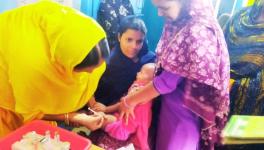Treatment Coverage for Mental Health Disorders Low Across the World: Study
Representational use only.
Treatment coverage for major depressive disorder (MDD) remains low across the world despite it being the leading cause of disability. According to research conducted by the Institute for Health Metrics and Evaluation, University of Washington, only 33% of people diagnosed with MDD in high-income countries and a meagre 8% in low- and lower-middle-income availed mental health services.
The study, published in PLOS journal—a nonprofit open-access science, technology, and medicine publisher—on February 15, aims to provide a comprehensive review of estimates of MDD treatment coverage and gaps by location and treatment type between 2000 and 2019.
Nearly, 75% of MDD patients across the globe live in low and lower-middle-income countries, the study, titled ‘The global gap in treatment coverage for major depressive disorder in 84 countries from 2000–2019: A systematic review and Bayesian meta-regression analysis’, showed.
The study was based on a meta-regression analysis of data from 149 studies, 342 data points and 84 countries between 2000 and 2021 on MDD treatment. While global health financing has historically been prioritised for malaria, HIV/AIDs and tuberculosis—which are some of the leading causes of disability and mortality in many low- and middle-income countries, financing for mental health is still far from adequate, it found.
In 2019, development assistance for health (DAH) for noncommunicable diseases (which includes mental disorders) for Sustainable Development Goal 3 targets was $0.7 billion for 135 low- and middle-income countries—which is less than 2% of the total estimated DAH in 2019 of $40.6 billion. “Therefore,” the study said, “it is important to align funding priorities with epidemiological shifts in countries that are likely to be accompanied by an increase in noncommunicable disease burden, including mental disorders.”
An earlier analysis had shown that scaling up effective treatment for depression and anxiety disorders leads to 43 million extra years of healthy life and a net present economic value of $310 billion between 2016 and 2030, the researchers said.
In conclusion, the study said, “Ultimately, our findings emphasise the need for governments and policymakers to reconsider the availability of appropriate care for MDD and facilitators of treatment as they respond to the large burden imposed by this disorder.”
MENTAL HEALTH EPIDEMIC IN INDIA
Mental illnesses—including depression, anxiety, schizophrenia and neuro-psychotic disorders—contribute 18.5% to the global disease burden. India bears a disproportionate component of this burden with 56 million cases of depression, 43 million anxiety disorders and a large number of people committing suicide daily. The World Health Organisation estimates the economic loss due to mental health conditions in India between 2012-2030 at Rs 75.84 lakh crore.
While developed countries allocate 5%-18% of their annual healthcare Budget for mental health, India spends roughly 0.05%. In a rare occurrence, the declining mental health among Indians found a mention in Union finance minister Nirmala Sitharaman’s Budget 2022-2023 speech. “The pandemic has accentuated mental health problems in people of all ages,” she said while announcing the launch of a National Tele Mental Health Programme to “improve the access to quality mental health counselling and care services”.
The programme will include a network of 23 tele mental health centres of excellence. “The National Institute of Mental Health and Neuro Sciences (NIMHANS) will be the nodal centre and the Indian Institute of Information Technology Bangalore will provide technological support,” Sitharaman said.
Besides, an open platform for the National Digital Health Ecosystem will be rolled out. “It will consist of digital registries of health providers and health facilities; a unique health identity; consent framework and universal access to healthcare facilities,” the minister said.
The National Mental Health Programme (NMHP) was launched in 1982. A District Mental Health Programme was further launched under NMHP under the Ninth Five-Year Plan in 1996. It is supposed to provide mental health services in 692 districts. Besides the NMHP, the Centre also funds two institutes NIMHANS Bengaluru and the Lokpriya Gopinath Bordoloi Regional Institute of Mental Health in Tezpur, Assam.
The Budget increased the allocation for NIMHANS from around Rs 500 crore to Rs 560 crore and the Lokpriya Gopinath Bordoloi Regional Institute of Mental Health from Rs 57 crore to 70 crore compared to the last fiscal.
Sadly, the grant for NMHP remained unchanged at Rs 40 crore. The allocation of funds towards mental healthcare services still makes up only 0.81% of the total outlay of Rs 71,269 crore for the ministry of health and family welfare.
Despite the low allocation for NMHP, the funds have been underutilised even during the pandemic. In 2021, the Parliamentary Standing Committee on Health and Family Welfare pointed out the underutilisation of funds. “The Committee is of the view that a constant underutilisation over the years under this head clearly points towards the ministry’s inability to comprehend the magnitude of mental health burden in the country.”
Despite studies highlighting “the high prevalence of mental illness in the country”, no “substantial progress has been achieved to facilitate a robust mechanism for delivery of mental healthcare services”, the Committee added.
In its analysis of the 2021–2022 Budget, the India Mental Health Observatory had mentioned that different population groups have faced varying levels of emotional distress which in some cases may have been worsened by psychosocial and economic factors, including loss of employment, depleted savings, and financial insecurity has plagued large swathes of the population, particularly those working in the informal sector. “The lack of social interaction has implications for the emotional and social development of children,” it had said.
Get the latest reports & analysis with people's perspective on Protests, movements & deep analytical videos, discussions of the current affairs in your Telegram app. Subscribe to NewsClick's Telegram channel & get Real-Time updates on stories, as they get published on our website.
























